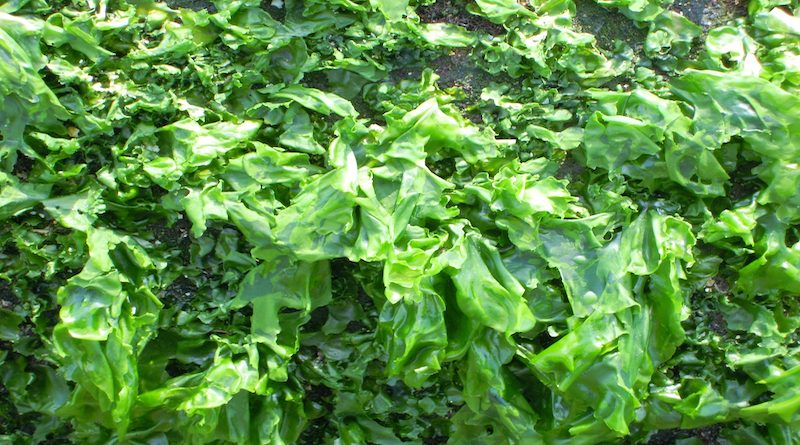SeaWheat Present Why And How You Should Be Eating More Ulva
The COST Action Tommorrow’s ‘Wheat of the Sea’: Ulva, a model for an innovative mariculture (SeaWheat) will facilitate acquainting the traditional European diet and taste with Ulva, as a new, sustainable, and safe food item. Its aim is to make a step-change towards a green economy based on Ulva mass production and utilization within the European community and beyond. The ultimate goal is the development of Ulva-based blue-biotech industries and its utilization as a model organism in European algaculture.
Ulva is a type of green seaweed that has a mild, slightly salty flavour with a slightly nutty aftertaste. The texture is usually tender, similar to spinach or lettuce, with a slightly chewy or crunchy texture depending on how it’s prepared. It’s often used in salads, soups, and as a garnish for seafood dishes. Overall, its taste can be described as refreshing, delicate, and briny, with a mild umami flavour.
How to prepare Ulva
Ulva can be prepared in a variety of ways, depending on personal preference. Regardless of the method you choose, it’s important to rinse the Ulva thoroughly in cold water before cooking to remove any sand or debris. Here are a few common methods:
- Raw: it can be eaten raw in salads or used as a garnish for seafood dishes. Simply chop it into bite-sized pieces.
- Steamed or blanched: to cook Ulva, you can steam or blanch it for a few minutes until it turns bright green and becomes slightly tender. Once cooked, you can add it to soups or stir-fries.
- Fried: another way to cook Ulva is to fry it until it’s crispy. Coat it in a light batter or breadcrumbs, and then deep-fry it until golden brown. This method creates a crunchy texture and can be served as a snack or side dish.
If you’re looking to start incorporating Ulva into your diet, here are some easy and tasty ways to prepare it:
Seaweed salad: make a simple seaweed salad by mixing sliced Ulva with sliced cucumbers, carrots, and a dressing made from soy sauce, rice vinegar, and sesame oil. This salad is refreshing, flavourful, and easy to make.
Miso soup with Ulva: add it sliced to miso soup for a nutritious and flavourful addition. Simply simmer the Ulva with dashi broth, miso paste, tofu, and scallions for a delicious and easy soup.
Stir-fry: stir-fry sliced Ulva with your favourite vegetables and protein for a healthy and flavourful meal. Try it with shrimp, mushrooms, and bell peppers, and season with garlic, soy sauce, and sesame oil.
No matter how you choose to prepare it, seaweed is a nutritious and delicious ingredient that’s easy to add to your diet.
Ulva is also suitable for animal consumption and is commonly used as a food source for many aquatic animals, including fish, crabs, and sea urchins. It is used as a feed supplement for livestock such as cows, pigs, and chickens as it’s highly nutritious and contains high levels of protein, vitamins, and minerals. In addition, Ulva is sustainable to harvest and grows rapidly, making it an environmentally friendly feed option for animals.
The benefits of Ulva
Overall, seaweed is a nutritious and sustainable food source that offers a range of benefits for both human and environmental health:
Nutritional benefits: Ulva is a rich source of nutrients, including protein, fiber, vitamins, and minerals such as iodine, iron, and calcium. It’s also low in calories and fat, making it a healthy addition to any diet.
Environmental benefits: Ulva aquaculture is a sustainable and environmentally friendly way to produce this nutritious seaweed, as it requires minimal resources and produces minimal waste.
Economic benefits: Ulva aquaculture can provide a source of income for coastal communities and create job opportunities in the aquaculture industry.
Culinary benefits: Ulva has a mild, slightly salty flavour and a tender texture, making it a versatile ingredient that can be used in a variety of dishes. It’s also a popular ingredient in many traditional dishes around the world, such as Japanese miso soup and Korean kimbap.
While Ulva is known to be a highly nutritious food, there is still much to be learned about its bioactive compounds and potential health benefits. Further research is needed to explore its full range of nutritional properties, including its potential as a functional food or nutraceutical.
Furthermore, while it has the potential to provide economic benefits to coastal communities, further research is needed to explore the economic viability of Ulva aquaculture. This includes assessing the costs and benefits of cultivation, identifying potential markets and value chains, and exploring the potential for job creation and economic development.
This is where SeaWheat steps in. “We aim to create an efficient network, active in all aspects and disciplines related to Ulva biology, biotechnology, engineering, aquaculture, nutrition, bioactivity and social aspects. Stakeholders and end users will be part of it, so as to create all the conditions required for the development of Ulva-based blue biotech industries and lay the foundations for future commercial applications.”

